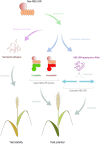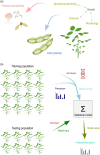The complex relationship between disease resistance and yield in crops
- PMID: 38743906
- PMCID: PMC11331782
- DOI: 10.1111/pbi.14373
The complex relationship between disease resistance and yield in crops
Abstract
In plants, growth and defence are controlled by many molecular pathways that are antagonistic to one another. This results in a 'growth-defence trade-off', where plants temporarily reduce growth in response to pests or diseases. Due to this antagonism, genetic variants that improve resistance often reduce growth and vice versa. Therefore, in natural populations, the most disease resistant individuals are often the slowest growing. In crops, slow growth may translate into a yield penalty, but resistance is essential for protecting yield in the presence of disease. Therefore, plant breeders must balance these traits to ensure optimal yield potential and yield stability. In crops, both qualitative and quantitative disease resistance are often linked with genetic variants that cause yield penalties, but this is not always the case. Furthermore, both crop yield and disease resistance are complex traits influenced by many aspects of the plant's physiology, morphology and environment, and the relationship between the molecular growth-defence trade-off and disease resistance-yield antagonism is not well-understood. In this article, we highlight research from the last 2 years on the molecular mechanistic basis of the antagonism between defence and growth. We then discuss the interaction between disease resistance and crop yield from a breeding perspective, outlining the complexity and nuances of this relationship and where research can aid practical methods for simultaneous improvement of yield potential and disease resistance.
Keywords: disease; growth; yield.
© 2024 The Author(s). Plant Biotechnology Journal published by Society for Experimental Biology and The Association of Applied Biologists and John Wiley & Sons Ltd.
Conflict of interest statement
The authors have not declared a conflict of interest.
Figures


Similar articles
-
Revisiting growth-defence trade-offs and breeding strategies in crops.Plant Biotechnol J. 2024 May;22(5):1198-1205. doi: 10.1111/pbi.14258. Epub 2024 Feb 27. Plant Biotechnol J. 2024. PMID: 38410834 Free PMC article. Review.
-
GM as a route for delivery of sustainable crop protection.J Exp Bot. 2012 Jan;63(2):537-41. doi: 10.1093/jxb/err281. Epub 2011 Oct 20. J Exp Bot. 2012. PMID: 22016426
-
Growth-defense trade-off in plants: From hypothesis to principle to paradigm.Cell Host Microbe. 2025 Aug 13;33(8):1222-1226. doi: 10.1016/j.chom.2025.05.022. Cell Host Microbe. 2025. PMID: 40812173
-
Endophytic Streptomyces hygroscopicus OsiSh-2-Mediated Balancing between Growth and Disease Resistance in Host Rice.mBio. 2021 Aug 31;12(4):e0156621. doi: 10.1128/mBio.01566-21. Epub 2021 Aug 10. mBio. 2021. PMID: 34372692 Free PMC article.
-
Molecular Basis of Disease Resistance and Perspectives on Breeding Strategies for Resistance Improvement in Crops.Mol Plant. 2020 Oct 5;13(10):1402-1419. doi: 10.1016/j.molp.2020.09.018. Epub 2020 Sep 29. Mol Plant. 2020. PMID: 32979566 Review.
Cited by
-
Integrating multi-omics and machine learning for disease resistance prediction in legumes.Theor Appl Genet. 2025 Jun 27;138(7):163. doi: 10.1007/s00122-025-04948-2. Theor Appl Genet. 2025. PMID: 40579624 Free PMC article. Review.
-
Rvi6-mediated defense mechanisms against apple scab.BMC Plant Biol. 2025 Aug 26;25(1):1137. doi: 10.1186/s12870-025-07117-1. BMC Plant Biol. 2025. PMID: 40859130 Free PMC article.
-
Pangenome analysis reveals structural variation associated with seed size and weight traits in peanut.Nat Genet. 2025 May;57(5):1250-1261. doi: 10.1038/s41588-025-02170-w. Epub 2025 Apr 28. Nat Genet. 2025. PMID: 40295880 Free PMC article.
-
Engineering tomato disease resistance by manipulating susceptibility genes.Front Genome Ed. 2025 Feb 10;7:1537148. doi: 10.3389/fgeed.2025.1537148. eCollection 2025. Front Genome Ed. 2025. PMID: 39995605 Free PMC article. Review.
-
The switch-liker's guide to plant synthetic gene circuits.Plant J. 2025 Mar;121(5):e70090. doi: 10.1111/tpj.70090. Plant J. 2025. PMID: 40052500 Free PMC article. Review.
References
-
- Araus, J.L. , Slafer, G.A. , Royo, C. and Serret, M.D. (2008) Breeding for Yield Potential and Stress Adaptation in Cereals. Crit. Rev. Plant Sci. 27, 377–412.
-
- Barbacci, A. , Navaud, O. , Mbengue, M. , Barascud, M. , Godiard, L. , Khafif, M. , Lacaze, A. et al. (2020) Rapid identification of an Arabidopsis NLR gene as a candidate conferring susceptibility to Sclerotinia sclerotiorum using time‐resolved automated phenotyping. Plant J. 103, 903–917. - PMC - PubMed
-
- Barton, N.H. , Etheridge, A.M. and Véber, A. (2017) The infinitesimal model: Definition, derivation, and implications. Theor. Popul. Biol. 118, 50–73. - PubMed
Publication types
MeSH terms
Grants and funding
LinkOut - more resources
Full Text Sources

